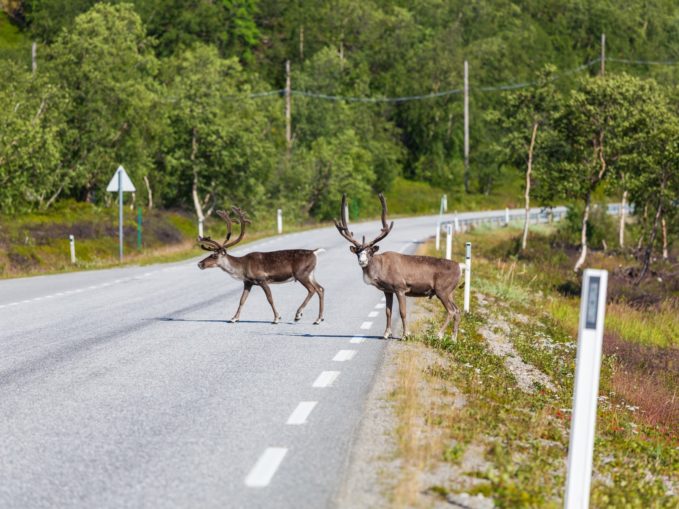
This year’s danger season may be exacerbated by the unique events of 2020, but recognizing it and preparing can empower drivers to make good choices in bad situations
By Donald Dunphy, Contributor
October 2020
Even in ordinary years, animal-to-vehicle collisions are a major problem for drivers both in fleet and otherwise. According to State Farm Insurance, the odds of a driver hitting a deer or other animals are 1 in 116. The company estimates that U.S. motorists made more than 1.9 million animal collision claims from July 1, 2018, to June 30, 2019. In 2018, the New York City Police Department recorded 103 deer-vehicle collisions around Staten Island — a five percent increase from the previous 98 collisions just a year before — and a 232 percent increase from 31 collisions in 2015.
Need we be reminded that 2020 has not been an ordinary year.
Perfect Storm
For starters, the winter of 2019-2020 was the sixth warmest winter on record for the United States. According to NOAA, this year’s “meteorological summer” — June through August’s end — ranked as fourth hottest, and in the driest one-third of all summers in the historical record. Abnormally warm weather is expected for October 2020-January 2021. Such heat has taken its toll on food stocks which would otherwise be available to deer and other herbivores in autumn and winter during mating season. (This is also the period that sees the most insurance claims on an annual basis.)
Then add on the unprecedented fires that rage across the western parts of the U.S., burning up plant life and natural habitat which managed to survive the droughts.
Even here, the specter of coronavirus disease 2019 (COVID-19) plays a role. As cited by NPR, the pandemic caused an unprecedented shift in U.S. traffic where total-miles-driven dropped by more than 40% in the last two weeks of March 2020, and in some states, mileage dropped more than 60% below normal. Diminished road usage carried on through the majority of the summer before states initiated “reopen” plans, getting vehicles back out in force.
In areas where natural predators are few to none at all, population control via animal-vehicle crashes – a grim side-benefit – was severely diminished.
It’s a “perfect storm” that promises more deer than usual competing for food and mates. All drivers, regardless of whether driving is their livelihood or otherwise must stay vigilant. For fleet professionals who face severe budget cuts and extended vehicle lifecycles to save money, awareness must be a bottom-line priority.
Next Steps
As reported on the website PolicyGenius.com, comprehensive coverage insurance policies will cover vehicles hitting deer. Even so, insurance is an after-the-crash solution. The goal is to prevent the crash in the first place, but animal-vehicle collisions are neither predictable nor always avoidable.
However, there are valuable steps fleet can take for the safety and well-being of all drivers, and the prolonged life of your assets.
Before vehicles hit the road:
- Communicate the heightened potential of animals in roadways to drivers.
- Make sure your distracted driving policy is updated, clearly communicated to your staff, and understood. Getting them to sign off on these is also helpful. Being a champion for eliminating distracted driving is a goal which organizations should get behind year-round, but is even more relevant when animal interventions are on the rise.
- Double-check that preventive maintenance is up-to-date with fresh brake pads and shoes, discs that are aligned and “true,” and calipers that won’t bind up. An inspection of vehicles with ABS systems is advised.
- Proper tires for the season with deep tread and plenty of “meat” on them are essential.
Once drivers are behind the wheel:
- Take animal-crossing signs seriously. These warnings are posted for a reason, as these areas are known for frequent incidents.
- Stay alert throughout the day and be mindful of vehicle speed, particularly at dusk and dawn.
- Deer move in groups, so if you see one, expect more nearby and proceed accordingly.
- Always buckle up and use your vehicle’s high beams whenever safe and appropriate.
- Driver instincts will usually kick in when an obstacle enters the road. If the foot goes to the brake, follow through, especially if the vehicle has responsive antilock equipment.
- Conversely, instincts may prompt drivers to swerve to avoid the hit, but this is more dangerous than simply colliding. Let the onboard safety equipment do the job instead of potentially hitting oncoming vehicles, trees, or other stationary obstacles.
- Make sure vehicles are clean and free from any impediments that might obstruct airbags. Those very obstructions could also become projectiles should airbags deploy.
- Keep your eyes on the road, off your phone, and avoid all distractions.
This year’s danger season may be exacerbated by the unique events of 2020, but recognizing it and preparing can empower drivers to make good choices in bad situations. Best of all, these steps can benefit drivers – in fleet or otherwise – all year long.
The post Preparing Your Fleet for an Unusually Active Vehicle-Animal Collision Season appeared first on Fleet Management Weekly.
from Fleet Management Weekly https://ift.tt/36GqzUR



Sourced by Quik DMV - CADMV fleet registration services. Renew your registration online in only 10 minutes. No DMV visits, no lines, no phone mazes, and no appointments needed. Visit Quik, Click, Pay & Print your registration from home or any local print shop.





0 comments:
Post a Comment